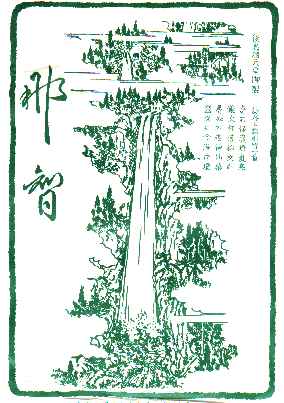 An Example of Shrine
Paper
An Example of Shrine
Paper
Japanese Religion
To speak of Japanese religion is to speak of art. Japanese thought has an aesthetic rather than a world view.
Zen informs this aesthetic but it affirms basic principles that can be found in Shinto -- the ancient Japanese religion. According to Shinto, the natural world is filled with spirit and power that can be tapped or can be refined in human activity.
Shinto means "the way of the Kami," but Kami is untranslatable into English. We can use the words "sacred force" to try and get at what Kami means, but better yet, we can begin to grasp the word by looking at the wide variety of ways that it is used in Japanese thought and practice.
In one of its aspects, Kami corresponds to our idea of diety or spirit. The mythological dieties in the creation story found in Kojiki and Nihongi belong to the age of kami. Speicific natural phemnomena such as trees, lakes (waterfalls (Todoroki no Taki ** and mountains (Fuji-san) may be kami. The word for thunder is "sounding kami./Aji-suki-taka-hi-kone." Animals and mythological creatures can also be kami (Hengeyokai).
Kami is an expression used by early Japanese people to classify experiences that evoked sentiments of caution and mystery in the presence of the manifestation of the strange and marvelous. When paper was introduced to Japan its importance was demarcated by calling it kami. Origami is, therefore, a Kami filled art form.
Japan itself is a sacred land, a land of kami, and the Emperor is a sacred leadership. Ancestors and living people can be kami. Perhaps you have heard the term in reference to the Japanese pilots who flew suicide missions in World War II. "Kami Kazi" means Kami wind.
Kojiki (Record of Ancient Matters) and Nihongi or Nihon Shoki (The Written Chronicles of Japan) contain ancient Japanese mythological writings including the story of the creation of Japan and the descent of the first emperor from the Sun Goddess: (birth of the god of fire ).
At the beginning of heaven and earth there came into existence many Kami. The world was not completely formed -- a mixture of water and land -- and the various kami produced other kami, eventually giving rise to a divine couple, Izanagi and his spouse, Ianami. Looking down from heaven on the still unformed earth, they dipped a jeweled spear into the ocean, and from this action the first islands -- solid land -- were formed [Japan].
The divine couple gave birth to other mythological figues, the most important of whom is the sun Goddess (Amaterasu ** Story) Later the sun goddess ordered her grandson, Ninigi, to descend to earth and rule it; as signs of this right to rule, she gave him a necklace, a mirror, and a sword. These three objects are still respected today as symbols of imperial power, and the emperor is regarded as a direct descendent of Ninigi. Shinto of the Imperial House.
According to the creation myths, Japan is a divine country led by a sacred emperor and inhabited by a people who had a special relationship to kami. These myths stress purity and perfection and the ethics of honor and shame as well as other Japanese ideals.
 An Example of Shrine
Paper
An Example of Shrine
Paper
Japanese Aesthetics
Aesthetics
"The primary aesthetic concept at the heart of traditional Japanese culture is the value of harmony in all things. The Japanese world view is nature-based and concerned with the beauty of studied simplicity and harmony with nature. These ideas are still expressed in every aspect of daily life, despite the many changes brought about by the westernization of Japanese culture. This Japanese aesthetic of the beauty of simplicity and harmony is called wabi-sabi (wah-bee sah-bee). " Nancy Walkup
A comparison of western and Japanese Aesthetics
Japanese spirituality is expressed in many art forms including:
Japanese Religious Eclecticism
Japanese religious life is marked by a great eclecticism. Besides the Shinto tradition, Confucian, Taoist principles and more significantly Buddhist influences have give shape to Japanese culture. Recent events indicate that Western religious ideas have also had an impact upon religious life in Japan. The Aum Shinri Kyo, infamous for its use of Sarin gas in Tokyo's subways, blends Christian eschatology and Buddhism. Its blind leader, Shoko Asahara, is in many ways typical of the Shamanic traditions of Taoism.
The follow is an attempt to chronicle influences:
Sixth Century C.E.
Japanese Buddhism finds expression in a number of new sects
Japan has also produced new religious movements such as Gedatsu-kai, a blend of Buddhism and Shinto beliefs, founded in 1929 by Eiz Okano. Okano taught that neglect of ancestor and other forms of worship was the cause of problems in one's life. Eventually the religion developed its own rituals for honoring family and meditation techniques.